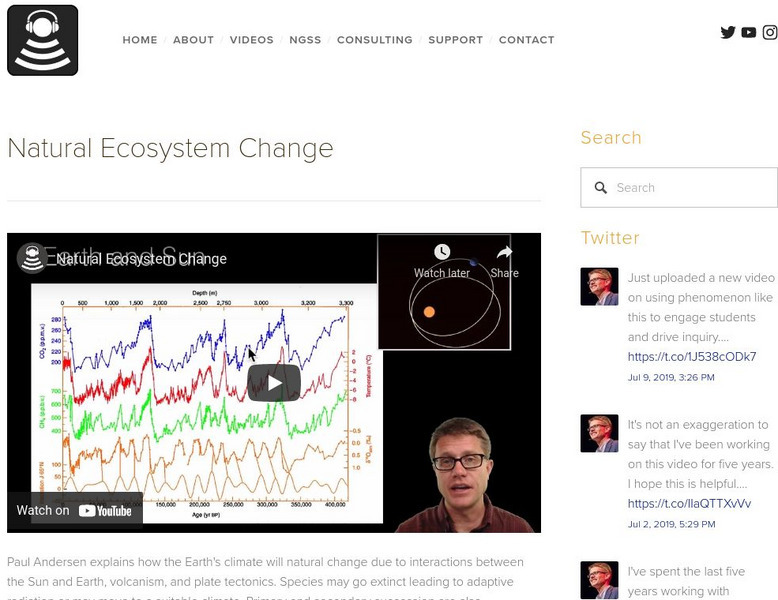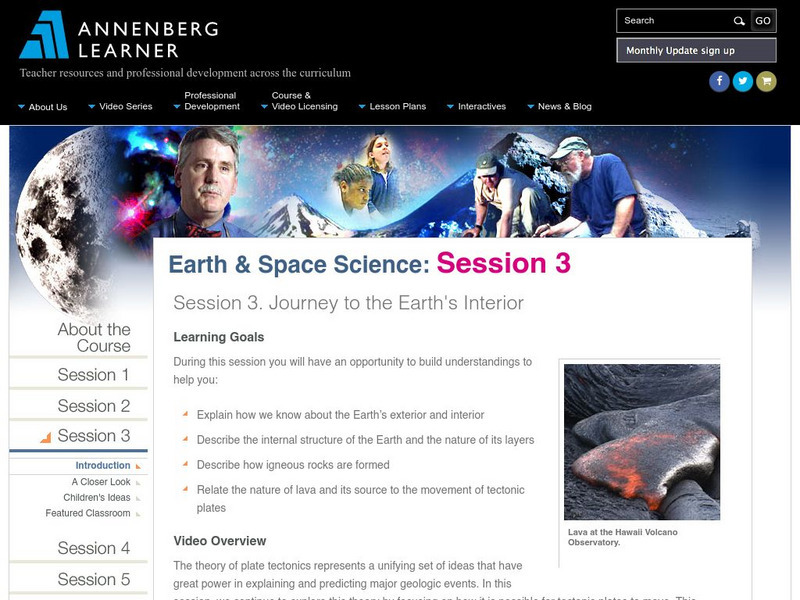TED-Ed
Why is Mount Everest so Tall?
Many years ago, when the Indian plate collided into the Eurasian plate, the highest mountain on Earth was formed. But what gives Mount Everest its shape? Watch an informative video to learn what factors make the...
Crash Course
The Sun and The Earth: Crash Course Big History #3
Amaze your class with the fact that more than 1,000 confirmed planets exist. The video explains the formation and development of planets, especially the earth. It covers the solar nebula, birth of the sun, and the development of the...
Khan Academy
Plate Tectonics: Geological Features of Divergent Plate Boundaries
Sal explains the mechanism of crust lift developing at hot spots. The density changes at that point, continuing to cause depressions. The depressions and thinner layers fill with water, resulting in a flooded rift valley.
Curated OER
Mid Ocean Ridges, Volcanoes, and the Arctic
Journey underwater for a better look at the tectonic plates and the volcanoes they create. Although this video is slightly dry, it is packed with valuable information and easy-to-understand visual images. Consider using a portion to...
TED-Ed
What Happens When Continents Collide?
Ever heard of the Great American Biotic Interchange? The joining of North and South America caused one of the greatest biological migrations in Earth's history. Watch the continents collide and learn about the global consequences.
Be Smart
How Does A Canyon Become Grand?
Ah, the Grand Canyon ... ain't it grand? The narrator of a video from PBS Digital Studios explains, in detail, how the Grand Canyon was formed over millions of years.
Fuse School
The Rock Cycle
Aren't all rocks the same? High school earth scientists can say "definitely not!" after viewing the second in a series of seven videos. Beginning with an easy analysis and comparison of sandstone and granite, class members follow the...
Howard Hughes Medical Institute
Continental Movement Over the Past 200 Million Years
Go for a ride on the continental drift. A video animation shows the movement of land over a period of 200 million years. The lesson instructor explains the shift during the animation and gives pupils a unique viewing perspective to...
PBS
Making North America | The Cascadia Subduction Zone
Scientists discovered a rain forest covered in sand and saltwater residue. This led to a collection of core samples and a rather intense prediction for the future of the American Pacific Northwest. Part of a larger series on the story of...
TED-Ed
Why Are Earthquakes so Hard to Predict?
Cell phones to crowdsource vibrations to warn of incoming earthquakes? Detectors to register high levels of radon-thoron isotopes? After detailing the factors that make earthquakes so difficult to predict, the narrator of a fascinating...
Khan Academy
Compositional and Mechanical Layers of the Earth, Cosmology and Astronomy
Sal details the chemical and mechanical composition of the Earth's crust, mantle, and core layers—a substantial addition to your geology or earth science lecture.
Howard Hughes Medical Institute
Holmes' Model of Convection
Convection currents do more than just bake a cake. A quick lesson demonstrates the convection currents of the earth and how they contribute to continental drift. An animation illustrates the movement of the currents and demonstrates how...
PBS
Pbs Learning Media: Plate Tectonics: Further Evidence
This video segment [2:12] adapted from A Science Odyssey uses animation and archival footage to provide an overview of the theory of plate tectonics.
Khan Academy
Khan Academy: Plate Tectonics: Difference Between Crust and Lithosphere
The instructor explores the plates in the makeup of Earth's surface. Evidence and theories about plate tectonics are featured. [8:00]
Other
E How Education: School Projects on Plate Tectonics
A science teacher demonstrates a number of simple models that teachers can use, or have students make, when teaching about plate tectonics and earthquakes. [5:38]
Bozeman Science
Bozeman Science: Plate Tectonics & Large Scale System Interactions
In this video, Paul Andersen explains how plate tectonics explains the large-scale system interactions on our planet. Large plates float on the mantle and interact to form the major landforms on the planet. Evidence for plate tectonics...
Bozeman Science
Bozeman Science: Plate Tectonics
Mr. Andersen describes how plate tectonics shapes our planet. Continental and oceanic platers are contrasted and major plate boundaries are discussed.
Annenberg Foundation
Annenberg Learner: Earth Revealed
To support or supplement a course in earth science or geography, Annenberg Media offers twenty-six Videos on Demand (VoDs). The topics coverd range from why Earth can sustain life, to plate tectonics, to rock types and landscape...
Bozeman Science
Bozeman Science: Geology
Paul Andersen explains how rock is formed and changed on the planet. The video begins with a brief description of rocks, minerals, and the rock cycle. Plate tectonics is used to describe structure near plate boundaries. Hot spots and...
Bozeman Science
Bozeman Science: Natural Ecosystem Change
Paul Andersen explains how the Earth's climate will natural change due to interactions between the Sun and Earth, volcanism, and plate tectonics. Species may go extinct leading to adaptive radiation or may move to a suitable climate....
Annenberg Foundation
Annenberg Learner: Earth and Space Science: Journey to the Earth's Interior
Material to begin an exploration of the Earth's interior. An hour-long video is accompanied by learning goals, an outline and overview, details on igneous rock, seismic waves, and the Earth's layers, and ideas for teaching this unit in...
Khan Academy
Khan Academy: Science Bulletins: Mapping the Heat Beneath
As seismic waves from earthquakes pass through the planet, their patterns can reveal hidden dynamics-hotspots, deep-diving rock, melting mantle-in Earth's interior. An array of seismometers that's being installed across the United States...
PBS
Pbs Learning Media: A Land Born in Fire
In this Nature video, follow geologists as they retrieve samples from a fresh batch of Kilauea's molten lava. [5:25]
PBS
Pbs Learning Media: Creating an Island Paradise
In this video segment from Nature, learn the geological process by which the next Hawaiian island will be formed. [1:12]





















